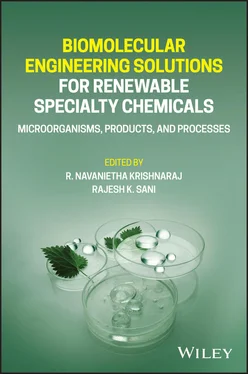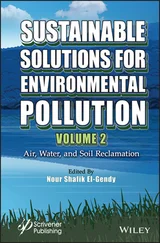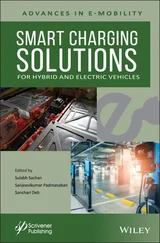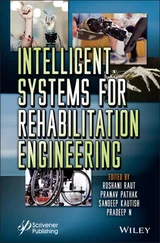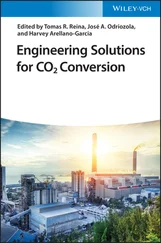1 ...6 7 8 10 11 12 ...29
1.3.1.2 Poly‐ϒ‐glutamic Acid
Poly‐ϒ‐glutamic acid is a naturally occurring, abundant poly amino acid which is water‐soluble, anionic, biodegradable, and edible biopolymer produced primarily by Bacillus subtilis . Glutamic acid can be L‐ and D‐ in nature linked by ϒ‐amide bond (Cao et al., 2018). Due to the presence of ϒ‐amide linkage, it is resistant to cleavage by proteases (Candela and Fouet, 2006). It is gaining importance because of being the potential candidate for drug delivery, cryoprotectant, thickening agent, biopolymer flocculant, bioabsorption of heavy metals, etc. (Bhattacharyya et al., 1998; Shih and Van, 2001). It is also widely used in skin serums in combination with vitamin C to increase skin elasticity and making it smooth (Tanimoto, 2010; BEN‐ZUR and GOLDMAN, 2007). Predominantly, Bacillus sp., such as Bacillus licheniformis, Bacillus subtilis, B. megaterium, Bacillus pumilis, Bacillus mojavensis , and Bacillus amyloliquefaciens , are producer of PGA. It is synthesized in ribosome independent manner. Glutamate is the precursor of PGA, which is derived from glutamic acid biosynthesis or glutamate transportation. In turn, α‐keto glutaric acid serves as a precursor for glutamate in tricarboxylic acid cycle (TCA) also known as Krebs cycle. The reaction is catalyzed by glutamate dehydrogenase in absence of glutamic acid, while 2‐oxoglutarate aminotransferase in presence of glutamic acid (Stadtman, 1966; Holzer, 1969). Furthermore, the glutamate units are joined together to produce PGA through racemization, polymerization, and anchoring or releasing. This can be studied in detail in review by Najar and Das (2015). PGA synthetase (Pgs), a membrane associated enzyme polymerizes glutamate to PGA. Genes encoding Pgs are different in different Bacillus species. Like Pgs is encoded by four genes (pgsB, C, A, and E) in B. licheniformis and B. amyloliquefaciens , capB, C, A, and E, in B. anthraci , while in B. subtilis they are ywsC , ywtABC . Role of pgsBCA operon was shown in B. subtilis for PGA production. Mutants with disrupted pgsBCA did not showed PGA synthesis. While the xylose‐induced pgsBCA operon started PGA synthesis (Ashiuchi et al., 2006). Sometimes the overexpression of pgsBCA leads to decrease in PGA production as seen in mutants of B. amyloliquefaciens (Feng et al., 2015).
Under nutrient deprivation conditions PGA is sometimes hydrolyzed by PGA hydrolases. Deletion of PGA hydrolases can increase the yield of PGA. Depending on where the PGA hydrolase will cleave PGA, it can be (i) PgdS (the γ‐DL‐glutamyl hydrolase) cleaves the γ‐glutamyl bond between D‐ and L‐glutamic acids residues of γ‐PGA; (ii) the D/L‐endopeptidase hydrolyzes the peptide bond between the glutamic acid residues; and (iii) the γ‐glutamyltransferase (GGT) possesses a powerful exo‐γ‐glutamyl hydrolase activity. The GGT is different from PgdS and D/L‐endopeptidase as it hydrolyzes the γ‐PGA from the N‐terminal to release both D‐ and L‐glutamic acids (Cao et al., 2018).
Hyaluronic acid (HA) also called as hyaluronan is a structural biopolymer produced by extracellular matrix of animal and human epithelial, neural, and connective tissues. HA is copolymer disaccharide between N‐acetyl‐ o ‐glucosamine and o ‐glucuronic acid linked by β1 → 3 and β1 → 4 glycosidic bonds. Due to the water retention properties of HA, it is widely used in cosmetics as it binds water to collagen and makes skin look plumper and more hydrated. Hyaluronic acid synthase (HAS‐a) is the integral enzyme present in the plasma membrane of mammalian cells and bacteria and synthesizes HA (Chen, 2002). It has several isoforms depending on the organism in which it is forming. Traditionally, it was extracted from animals that pose threat of infection from the animal source. Its bacterial production started with using Streptococcus zooepidemicus with a production titer value of 5–10 g/l in batch fermentation. Later, S. zooepidemicus was considered to be a human pathogen and was not GRAS. HA being viscous in nature pose problems in fermentation leading to lower yields. This leads to optimization of fermentation conditions and improvement in the strains genetically (Chong et al., 2005).
Hyaluronidase enzyme activity in the strains is not beneficial as it depolymerizes HA. Kim et al. (1996a) selected Streptococcus equi chemically derived mutant strain (after nitroglycerine treatment) which is nonhemolytic, hyaluronidase‐negative in nature, thus producing high molecular weight HA. Controlled expression of hyaluronidase is beneficial too as it reduces the molecular weight and viscosity of HA. Expressing tuaD, gtaB, glmU, glmM, and glmS genes plus glycolytic pathway genes in B. subtilis with controlled expression of hyaluronidase by N‐terminal engineering increased production from 5.96 to 19.38 g/l (Jin et al., 2016). HA produced from this strategy was low in molecular weight in the range of 2.20 × 103 to 1.42×106 Da. One of the reasons Streptococcus sp. were not considered as GRAS is that they produce streptolysin which causes haemolysis. Streptococcus equisimilis CVCC55116 mutated by ultraviolet ray combined with 60C o‐γ ray treatment produces 174.76 mg/L HA without producing streptolysin (Chen et al., 2012).
In an attempt to find the GRAS producers of HA, B. subtilis , Lactococcus lactis , E. coli , Pichia pastoris, Corynebacterium glutamicum , etc. were engineered to express HAS‐a, b (UDP‐glucose 6‐dehygrogenase), c (glucose‐1‐P uridyltransferase), d and e gene, which using precursors N ‐acetyl‐ o ‐glucosamine and o ‐glucuronic acid forms HA (Jia et al., 2013; Kaur and Jayaraman, 2016; Jeong et al., 2014). Lactococcus lactis is not the natural producer of HA due to absence of HAS gene. The attempt to express HAS gene in L. lactis was performed by number of research groups by using non‐integrative plasmids pRKN, pNZ8148, etc. (Prasad et al., 2010; Chien and Lee, 2007; Prasad et al., 2012). Strains expressing only HAS‐a and b genes give a production of 0.097 g/l, while the one expressing HAS‐c gene also gives the maximum production of 0.234 g/l (Prasad et al., 2010). This indicates the importance of HAS‐c gene expression for HA production. This is due to the fact that HAS‐c diverts the flux of glucose‐1‐phosphate toward UDP‐glucose synthesis, which is critical for HA synthesis. Genome integrative approach is also carried in Lactobacillus sp. giving twofold increase in the production and molecular weight (MW) of HA in comparison to plasmid bearing strains (Hmar et al., 2014). It was explained by the precursors ( N ‐acetyl‐ o ‐glucosamine/ o ‐glucuronic acid) and HAS‐a/HAS‐b mRNA ratio. In genome‐integrated strains HAS‐b expression was high compared to HAS‐a, which gives greater availability of precursors to bind to HA synthase leading to high MW HA. E. coli the most common microbe to be engineered has a wide variety of genetic tools available to be modified. It was the first microorganism in which human HAS was successfully expressed (Hoshi et al., 2004).
1.3.1.4 Polyhydroxyalkoate
Poly‐3‐hydroxyalkanoates (PHA) are polyesters that have gained economic importance due to their biodegradability and tendency to replace petroleum synthetic polymers. PHAs are produced in the form of intracellular inclusion bodies under nutrient deprivation and carbon source excess conditions. These inclusion bodies or PHA granules serve as carbon reserves for microorganisms during stress conditions (Sudesh et al., 2000). The inclusion bodies have PHA hydrophobic core surrounded by PHA synthase involved in synthesis of PHA (Grage et al., 2009). Depending on the number of monomeric units PHA can be divided into short chain length (SCL), medium chain length (MCL), and combination of both (SCL/MCL). SCL PHA have three to five carbons in the monomeric unit, is thermoplastic nature, brittle, and lacks toughness (3‐hydroxypropionate). MCL PHA have monomers consisting of six to fourteen carbons and have elastomeric property (3‐hydroxytetradecanoate). SCL/MCL PHA are derived from both short‐chain‐length and long‐chain‐length PHA having three to fourteen carbons. It has a wide range of physical and thermal properties. The generalized structure of PHA is shown in Figure 1.2. Till date 150 different PHAs composition have been identified according to the modifications made in existing PHA and genetically engineered organisms to produce PHA (Loos, 2011; Zinn and Hany, 2005). Apart from its application to produce bioplastics PHA has application in the field of tissue engineering, drug carrier, biomedical, etc. The widespread use of PHA is still restricted due to the fact that the cost of production of PHA is 5–10 times the cost of petrochemical‐derived plastic (Chen, 2009).
Читать дальше
